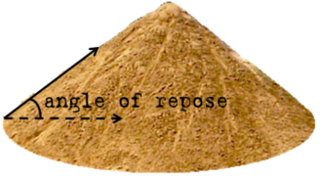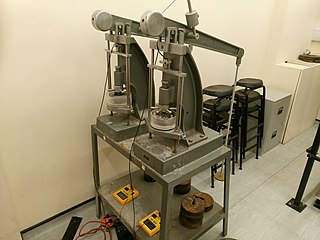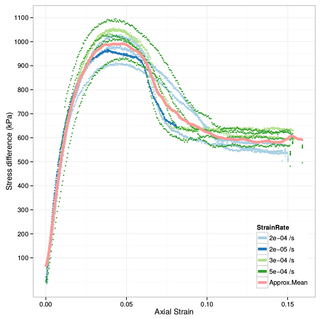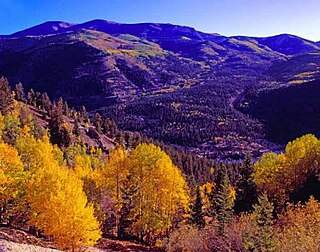 W
WSoil mechanics is a branch of soil physics and applied mechanics that describes the behavior of soils. It differs from fluid mechanics and solid mechanics in the sense that soils consist of a heterogeneous mixture of fluids and particles but soil may also contain organic solids and other matter. Along with rock mechanics, soil mechanics provides the theoretical basis for analysis in geotechnical engineering, a subdiscipline of civil engineering, and engineering geology, a subdiscipline of geology. Soil mechanics is used to analyze the deformations of and flow of fluids within natural and man-made structures that are supported on or made of soil, or structures that are buried in soils. Example applications are building and bridge foundations, retaining walls, dams, and buried pipeline systems. Principles of soil mechanics are also used in related disciplines such as geophysical engineering, coastal engineering, agricultural engineering, hydrology and soil physics.
 W
WThe angle of repose, or critical angle of repose, of a granular material is the steepest angle of descent or dip relative to the horizontal plane to which a material can be piled without slumping. At this angle, the material on the slope face is on the verge of sliding. The angle of repose can range from 0° to 90°. The morphology of the material affects the angle of repose; smooth, rounded sand grains cannot be piled as steeply as can rough, interlocking sands. The angle of repose can also be affected by additions of solvents. If a small amount of water is able to bridge the gaps between particles, electrostatic attraction of the water to mineral surfaces will increase the angle of repose, and related quantities such as the soil strength.
 W
WSoil consolidation refers to the mechanical process by which soil changes volume gradually in response to a change in pressure. This happens because soil is a two-phase material, comprising soil grains and pore fluid, usually groundwater. When soil saturated with water is subjected to an increase in pressure, the high volumetric stiffness of water compared to the soil matrix means that the water initially absorbs all the change in pressure without changing volume, creating excess pore water pressure. As water diffuses away from regions of high pressure due to seepage, the soil matrix gradually takes up the pressure change and shrinks in volume. The theoretical framework of consolidation is therefore closely related to the diffusion equation, the concept of effective stress, and hydraulic conductivity.
 W
WCritical State Soil Mechanics is the area of soil mechanics that encompasses the conceptual models that represent the mechanical behavior of saturated remolded soils based on the Critical State concept.
 W
WDilatancy is the volume change observed in granular materials when they are subjected to shear deformations. This effect was first described scientifically by Osborne Reynolds in 1885/1886 and is also known as Reynolds dilatancy.
 W
WDiscontinuity layout optimization (DLO) is an engineering analysis procedure which can be used to directly establish the amount of load that can be carried by a solid or structure prior to collapse. Using DLO the layout of failure planes, or 'discontinuities', in a collapsing solid or structure are identified using mathematical optimization methods. It is assumed that failure occurs in a ductile or 'plastic' manner.
 W
WThe Drucker–Prager yield criterion is a pressure-dependent model for determining whether a material has failed or undergone plastic yielding. The criterion was introduced to deal with the plastic deformation of soils. It and its many variants have been applied to rock, concrete, polymers, foams, and other pressure-dependent materials.
 W
WAn earthflow is a downslope viscous flow of fine-grained materials that have been saturated with water and moves under the pull of gravity. It is an intermediate type of mass wasting that is between downhill creep and mudflow. The types of materials that are susceptible to earthflows are clay, fine sand and silt, and fine-grained pyroclastic material.
 W
WThe Effective stress can be defined as the stress, depending on the applied tension and pore pressure , which controls the strain or strength behaviour of soil and rock for whatever pore pressure value or, in other terms, the stress which applied over a dry porous body provides the same strain or strength behaviour which is observed at ≠ 0. In the case of granular media it can be viewed as a force that keeps a collection of particles rigid. Usually this applies to sand, soil, or gravel, as well as every kind of rock and several other porous materials such as concrete, metal powders, biological tissues etc. The usefulness of an appropriate ESP formulation consists in allowing to assess the behaviour of a porous body for whatever pore pressure value on the basis of experiments involving dry samples.
 W
WFault zone hydrogeology is the study of how brittlely deformed rocks alter fluid flows in different lithological settings, such as clastic, igneous and carbonate rocks. Fluid movements, that can be quantified as permeability, can be facilitated or impeded due to the existence of a fault zone. This is because different mechanisms that deform rocks can alter porosity and permeability within a fault zone. Fluids involved in a fault system generally are groundwater and hydrocarbons.
 W
WFrost heaving is an upwards swelling of soil during freezing conditions caused by an increasing presence of ice as it grows towards the surface, upwards from the depth in the soil where freezing temperatures have penetrated into the soil. Ice growth requires a water supply that delivers water to the freezing front via capillary action in certain soils. The weight of overlying soil restrains vertical growth of the ice and can promote the formation of lens-shaped areas of ice within the soil. Yet the force of one or more growing ice lenses is sufficient to lift a layer of soil, as much as 1 foot or more. The soil through which water passes to feed the formation of ice lenses must be sufficiently porous to allow capillary action, yet not so porous as to break capillary continuity. Such soil is referred to as "frost susceptible". The growth of ice lenses continually consumes the rising water at the freezing front. Differential frost heaving can crack road surfaces—contributing to springtime pothole formation—and damage building foundations. Frost heaves may occur in mechanically refrigerated cold-storage buildings and ice rinks.
 W
WGroundwater is the water present beneath Earth's surface in soil pore spaces and in the fractures of rock formations. A unit of rock or an unconsolidated deposit is called an aquifer when it can yield a usable quantity of water. The depth at which soil pore spaces or fractures and voids in rock become completely saturated with water is called the water table. Groundwater is recharged from the surface; it may discharge from the surface naturally at springs and seeps, and can form oases or wetlands. Groundwater is also often withdrawn for agricultural, municipal, and industrial use by constructing and operating extraction wells. The study of the distribution and movement of groundwater is hydrogeology, also called groundwater hydrology.
 W
WGroundwater recharge or deep drainage or deep percolation is a hydrologic process, where water moves downward from surface water to groundwater. Recharge is the primary method through which water enters an aquifer. This process usually occurs in the vadose zone below plant roots and, is often expressed as a flux to the water table surface. Groundwater recharge also encompasses water moving away from the water table farther into the saturated zone. Recharge occurs both naturally and through anthropogenic processes, where rainwater and or reclaimed water is routed to the subsurface.
 W
WGroundwater-related subsidence is the subsidence of land resulting from groundwater extraction. It is a growing problem in the developing world as cities increase in population and water use, without adequate pumping regulation and enforcement. One estimate has 80% of serious U.S. land subsidence problems associated with the excessive extraction of groundwater, making it a growing problem throughout the world.
 W
WGrousers are devices intended to increase the traction of continuous tracks, especially in loose material such as soil or snow. This is done by increasing contact with the ground with protrusions, similar to conventional tire treads, and analogous to athletes' cleated shoes. On tanks and armoured vehicles, grousers are usually pads attached to the tracks; but on construction vehicles they may take the form of flat plates or bars.
 W
WThe Interference of the footings is a phenomenon that is observed when two footings are closely spaced. The buildings when are to be constructed nearby to each other, the architectural requirements or the less availability of space for the construction forces the engineers to place the foundation footings close to each other, and when foundations are placed close to each other with similar soil conditions, the Ultimate Bearing Capacity of each foundation may change due to the interference effect of the failure surface in the soil.
 W
WThe International Society for Soil Mechanics and Geotechnical Engineering (ISSMGE) is an international professional association, presently based in London, representing engineers, academics and contractors involved in geotechnical engineering. It is a federation of 89 member societies representing 90 countries around the world, which together give it a total of some 19,000 individual members. There are also 38 corporate associates from industry. The current ISSMGE President is Professor Charles W.W. Ng of The Hong Kong University of Science and Technology.
 W
WLateral earth pressure is the pressure that soil exerts in the horizontal direction. The lateral earth pressure is important because it affects the consolidation behavior and strength of the soil and because it is considered in the design of geotechnical engineering structures such as retaining walls, basements, tunnels, deep foundations and braced excavations.
 W
WThere are six soil deposits in India. They are Alluvial soil, Black soil or regur, Red soil, Laterite soil, Desert or Arid soil, and Forest and mountainous soil. These soils are formed by the sediments brought down by the rivers. They are also rich in chemical ingredients.
 W
WPersistence determines the possibilities of relative movement along a discontinuity in a soil or rock mass in geotechnical engineering. Discontinuities are usually differentiated in persistent, non-persistent, and abutting discontinuities (figure).
 W
WQuicksand is a colloid consisting of fine granular material and water.
 W
WRock mechanics is a theoretical and applied science of the mechanical behavior of rock and rock masses; compared to geology, it is that branch of mechanics concerned with the response of rock and rock masses to the force fields of their physical environment.
 W
WShear strength is a term used in soil mechanics to describe the magnitude of the shear stress that a soil can sustain. The shear resistance of soil is a result of friction and interlocking of particles, and possibly cementation or bonding at particle contacts. Due to interlocking, particulate material may expand or contract in volume as it is subject to shear strains. If soil expands its volume, the density of particles will decrease and the strength will decrease; in this case, the peak strength would be followed by a reduction of shear stress. The stress-strain relationship levels off when the material stops expanding or contracting, and when interparticle bonds are broken. The theoretical state at which the shear stress and density remain constant while the shear strain increases may be called the critical state, steady state, or residual strength.
 W
WSoil liquefaction occurs when a saturated or partially saturated soil substantially loses strength and stiffness in response to an applied stress such as shaking during an earthquake or other sudden change in stress condition, in which material that is ordinarily a solid behaves like a liquid. In soil mechanics, the term "liquefied" was first used by Allen Hazen in reference to the 1918 failure of the Calaveras Dam in California. He described the mechanism of flow liquefaction of the embankment dam as:If the pressure of the water in the pores is great enough to carry all the load, it will have the effect of holding the particles apart and of producing a condition that is practically equivalent to that of quicksand… the initial movement of some part of the material might result in accumulating pressure, first on one point, and then on another, successively, as the early points of concentration were liquefied.
 W
WSubsidence is the sudden sinking or gradual downward settling of the ground's surface with little or no horizontal motion. The definition of subsidence is not restricted by the rate, magnitude, or area involved in the downward movement. It may be caused by natural processes or by human activities. The former include various karst phenomena, thawing of permafrost, consolidation, oxidation of organic soils, slow crustal warping, normal faulting, caldera subsidence, or withdrawal of fluid lava from beneath a solid crust. The human activities include sub-surface mining or extraction of underground fluids, e. g. petroleum, natural gas, or groundwater. Ground subsidence is of global concern to geologists, geotechnical engineers, surveyors, engineers, urban planners, landowners, and the public in general.
 W
WThixotropy is a time-dependent shear thinning property. Certain gels or fluids that are thick or viscous under static conditions will flow over time when shaken, agitated, shear-stressed, or otherwise stressed. They then take a fixed time to return to a more viscous state. Some non-Newtonian pseudoplastic fluids show a time-dependent change in viscosity; the longer the fluid undergoes shear stress, the lower its viscosity. A thixotropic fluid is a fluid which takes a finite time to attain equilibrium viscosity when introduced to a steep change in shear rate. Some thixotropic fluids return to a gel state almost instantly, such as ketchup, and are called pseudoplastic fluids. Others such as yogurt take much longer and can become nearly solid. Many gels and colloids are thixotropic materials, exhibiting a stable form at rest but becoming fluid when agitated. Thixotropy arises because particles or structured solutes require time to organize. An overview of thixotropy has been provided by Mewis and Wagner.
 W
WWater content or moisture content is the quantity of water contained in a material, such as soil, rock, ceramics, crops, or wood. Water content is used in a wide range of scientific and technical areas, and is expressed as a ratio, which can range from 0 to the value of the materials' porosity at saturation. It can be given on a volumetric or mass (gravimetric) basis.